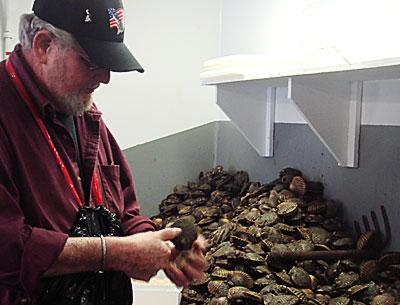A Scallop Bounty Here in Time For Thanksgiving

Scallop season opened in town waters on Monday with a healthy crop from Napeague Harbor providing local markets with the much-anticipated plump nuggets that many on the East End associate with Thanksgiving. And now there’s a new way to eat them.
At the Lester shucking shed on Abraham’s Path in East Hampton on Tuesday, the door opened and a visitor was greeted by a smell of clean, mossy sweetness as the scallop meats, which have almost religious status here, flew from Jimmy Lester’s hands.
The veteran shucker mused about shucking as the offerings piled up in a plastic tub, and the empty shells clattered into a barrel. “I used to shuck five pounds and have a cigarette. Every five pounds a cigarette. I’m much faster since I quit.”
Bruce Sasso of Stuart’s Market in Amagansett, where scallops were for sale this week for $24.99 a pound, described those from Napeague as “a nice large scallop. The guys had their limit rather quickly. Everyone is on the same spot, so who knows how long it will last. But they’re the best we’ve seen in a long time.”
That the crop will be smaller than last year is the result of an ominous algae bloom, particularly in state waters like Northwest Harbor, which usually provides most of those on the South Fork.
But while shucking proceeded here, Greg Rivara, a biologist and scallop specialist with the Cornell Cooperative Extension, was on a Long Island Rail Road train headed to the famous Oyster Bar in New York’s Grand Central Station with a sample bag of something new.
The different product, okayed for sale by the State Department of Environmental Conservation on June 25, is a yearling, ranging from the size of a quarter to a silver dollar. They are steamed open, clam-like, and eaten whole — pretty blue eyes, whisker-like tentacles, roe, digestive gland and all — the stuff normally discarded when a mature scallop’s adductor muscle is cut from the shell, the way Jimmy Lester, and generations of local shuckers before him, have done it.
When they are steamed, their body parts curl up around the adductor, adding substance and flavor, Mr. Rivara said. The new product and the traditional one can be compared to the difference between veal and steak, he said. “They’re delicious served on the shell like mussels and small hard clams.”
The Cooperative Extension has joined forces with four North Fork oyster farmers, including Mr. Rivara, to market yearlings, which are smaller than the legal size of those taken in the wild. Unlike larger scallops, for which harvesting seasons are regulated, growers are being allowed to set their own season for yearlings. However, they can only be sold in the shell; the state does not allow them to be sold as shucked meats.
Mr. Rivara said harvesting yearlings from farmed scallops was considered decades ago, and was calculated at the time to have a market value of $1 million in New York State alone.
On Saturday, Mr. Rivara squired Florence Fabricant, The New York Times food columnist, out to see the scallops in their farmed beds.
East End Oysters in Great Peconic Bay, Cornell Oysters of Southold (no relation to Cornell University or its Cooperative Extension), Widows Hole Oyster Company of Greenport, and the Oyster Pond Shellfish Company of Orient are cooperating in the project.
The new product will not be available in volume until sometime in 2013, Mr. Rivara said, although the growers have a number on hand and would welcome hearing from anyone interested in giving them a try.
